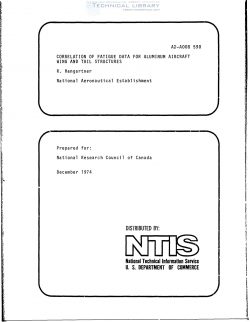NTIS-AD-A-008-590
- Version
- 259 Downloads
- 2.18 MB File Size
- 1 File Count
- March 7, 2017 Create Date
- March 7, 2017 Last Updated
Correlation of Fatigue Data for Aluminum Aircraft Wing and Tail Structures

S-N curves are derived for aluminum wing and tail structures by fitting various regression models to. 246 full-scale constant-amplitude fatigue test results from twelve types of aircraft structures. The derived curves were tested by comparing the predicted lives with actual. test results of various aircraft structures fatigue tested to variable-amplitude loads spectra. More reliable predictions resulted from these derived S-N curves than from existing S-N curves.
1.0 INTRODUCTION This document establishes more consistent S-N curves for the fatigue life prediction of alu- minum aircraft wing structures than the presently available RAeS-ESDU S-N curves for "Typical Wings and Tailplanes" (Ref. 1). Constant-amplitude fatigue test results from 246 aircraft wings and tails from twelve aircraft types were pooled and various regression models were fitted in order to obtain mathematical expressions for sets of S.N curves. These curves and the existing RAeS.ESDU curves were then used to predict the lives Of variable-amplitude tests and the calculated lives were compared with the actual test results. In the life calculations the method Of linear cumulative dam$.ge (Palmgen-Miner Rule) was utilized. 2.0 s-N CURVES DERIVED FROM FULL-SCALE STRUCTURES When estimating the life of a wing structure when structural details and an extensive stress analysis of the wing are not available it is normally better to use S-N curves derived from built-up struc• tures than those derived from notched material coupons. Reasons for this include the fact that there is no fretting in a simple specimen and a simple specimen has only one load path whereas many struc- tures are redundant. RAeS•ESDU published a set Of S-N curves derived from 137 full-scale fatigue tests on wings and tailplanes of various aluminum alloy aircraft structures (Ref. 1). These data and curves are re- produced in Figures 1 and 2. Upon inspection of Figure 2 it is noticed that the curves do not follow the same general trend. It is easily seen that the line for five ksi mean stress does not follow the pattern of the lines for the other mean stresses. It is understood that the curves were drawn by "eye" and to illustrate this inconsistency the slopes and intercepts Of the lines were plotted.
| File | Action |
|---|---|
| NTIS-AD-A-008-590 Correlation of Fatigue Data for Aluminum Aircraft Wing and Tail Structures.pdf | Download |

Comment On This Post